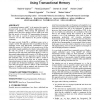SAC
2010
ACM
14 years 7 months ago
2010
ACM
Hardware transactional memory is a promising synchronization technology for chip-multiprocessors. It simplifies programming of concurrent applications and allows for higher concu...
SYSTOR
2009
ACM
14 years 7 months ago
2009
ACM
Apache is a large-scale industrial multi-process and multithreaded application, which uses lock-based synchronization. We report on our experience in modifying Apache’s cache mo...
HASKELL
2009
ACM
14 years 7 months ago
2009
ACM
We address the problem of reasoning about Haskell programs that use Software Transactional Memory (STM). As a motivating example, we consider Haskell code for a concurrent non-det...
OTM
2009
Springer
14 years 7 months ago
2009
Springer
Abstract. In this experience report, we present an evaluation of different techniques to manage concurrency in the context of application servers. Traditionally, using entity beans...
ISAAC
2009
Springer
14 years 7 months ago
2009
Springer
Abstract. In a multicore transactional memory (TM) system, concurrent execution threads interact and interfere with each other through shared memory. The less interference a progra...
CONCUR
2009
Springer
14 years 7 months ago
2009
Springer
Abstract. We examine the role of transactional memory from two perspectives: that of a programming language with atomic actions and that of implementations of the language. We argu...
MICRO
2009
IEEE
14 years 7 months ago
2009
IEEE
Transactional Memory aims to provide a programming model that makes parallel programming easier. Hardware implementations of transactional memory (HTM) suffer from fewer overhead...
IISWC
2009
IEEE
14 years 7 months ago
2009
IEEE
— Programming to exploit the resources in a multicore system remains a major obstacle for both computer and software engineers. Transactional memory offers an attractive alternat...
LCTRTS
2009
Springer
14 years 7 months ago
2009
Springer
Embedded systems, like general-purpose systems, can benefit from parallel execution on a symmetric multicore platform. Unfortunately, concurrency issues present in general-purpos...
ICS
2009
Tsinghua U.
14 years 7 months ago
2009
Tsinghua U.
“Is transactional memory useful?” is the question that cannot be answered until we provide substantial applications that can evaluate its capabilities. While existing TM appli...





